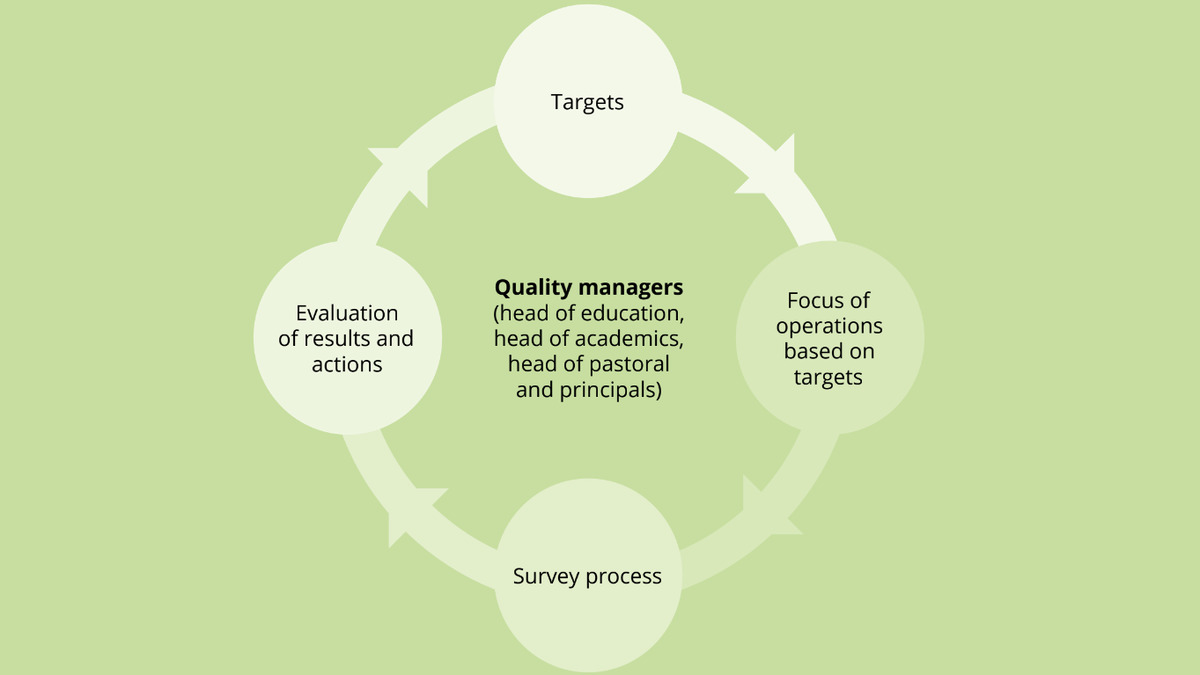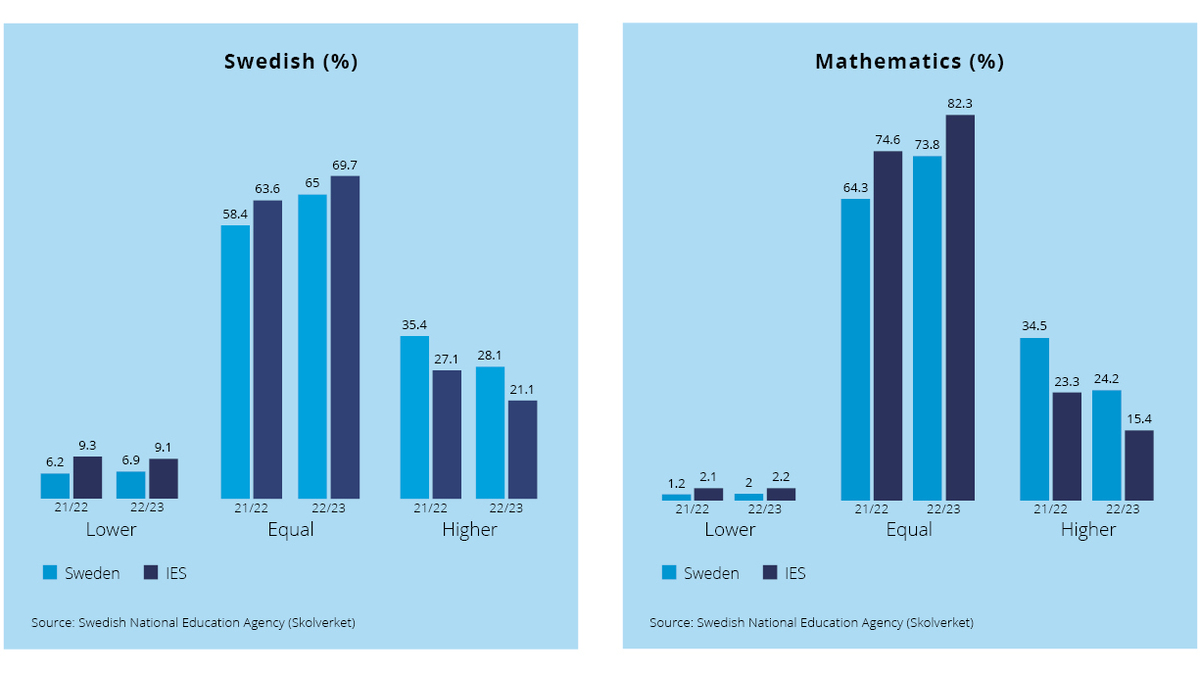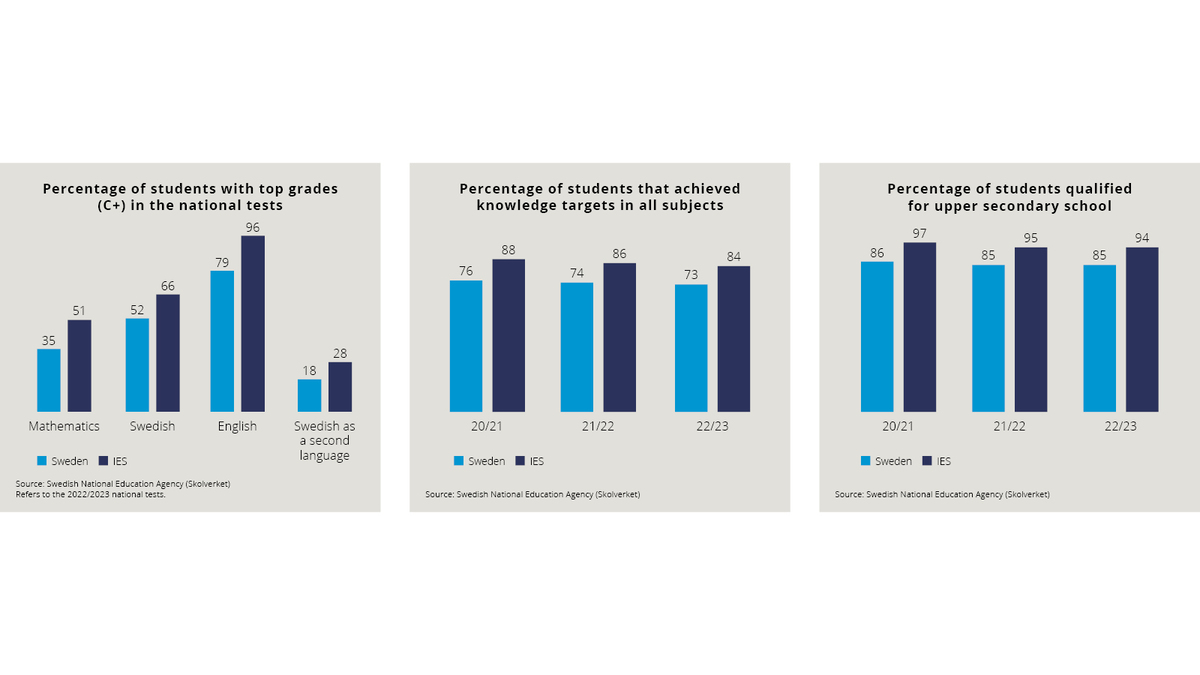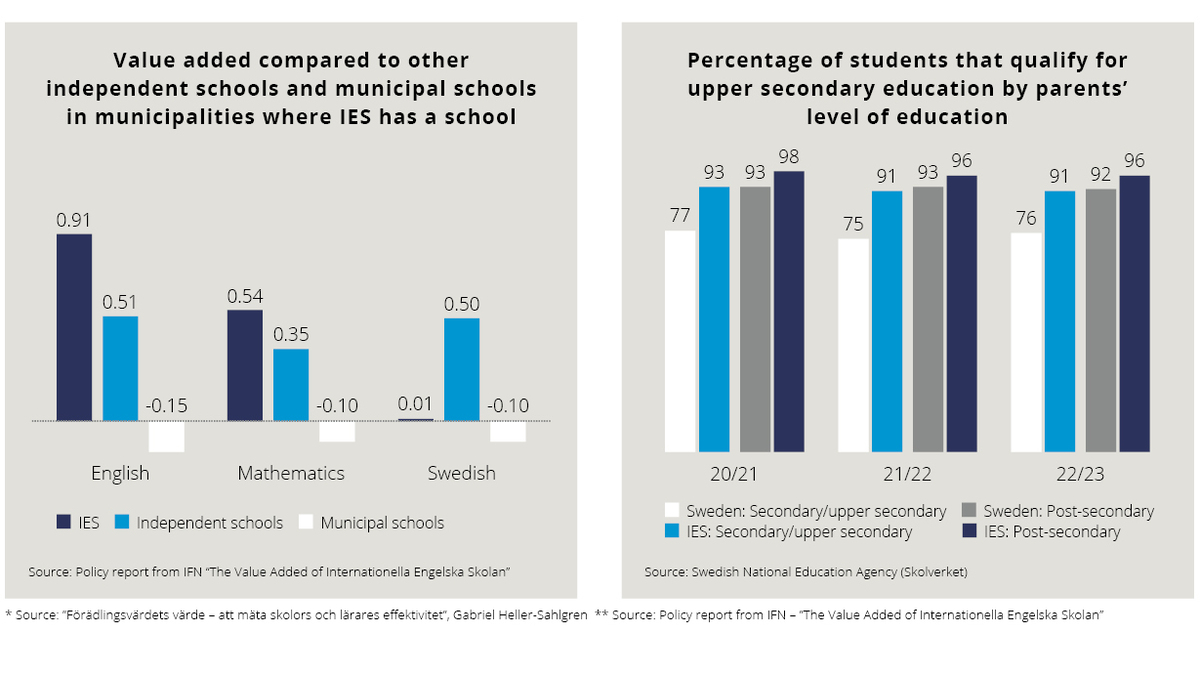
Internationella Engelska Skolan is a bilingual Swedish school with an international profile, where each student is given the opportunity to achieve high academic expectations and aspirations and where teaching takes place in a safe and calm environment. The organisation was founded in 1993 with one school in central Stockholm – which means that IES is celebrating its 30-year anniversary in the 2023/2024 academic year.
Our organisation has always believed in the same basic idea, that there must be a high level of quality in our education and that teachers must have high academic expectations for their students, regardless of their starting point. One important factor here is creating a supportive, safe and dynamic environment that helps to generate a positive view of school and the learning experience. In other words, it’s about “hard” and “soft” quality. IES follows a systematic approach to ensure quality and identify potential areas for improvement, including regular evaluation, action and follow-up. These areas are based on several different indicators including surveys, qualification for upper secondary school, national tests and admissions to higher education.
STRUCTURED FOLLOW-UP
Throughout the entire organisation there is a strong desire to keep improving so as to fulfil our promise to parents and students. While it can be difficult to measure and compare the quality of different schools, one set of measurements that can be used are the national test results, as these tests are conducted by all schools in Sweden. This is why IES has focused on following up the results of these tests for many years. When measured over time, the results of IES’ students are approximately 15 per cent higher than the national average in the subjects of mathematics, Swedish and English. One of the primary goals for IES is for all students to qualify for further studies. In the 2022/2023 academic year, 94 per cent of IES students qualified for upper secondary school, compared with 85 per cent for Sweden as a whole.
STRONG AND CLEAR LEADERSHIP
Strong local school leadership is an important parameter for a safe and orderly school environment. This is in turn essential to effective learning – in other words to achieving quality. IES is driven by its core values and recruits principals who live and lead according to these. The role of the principals is to ensure that IES’ core values are converted into actions and behaviours, every day.
This work is based on our Basic Defining Policy, which describes IES’ targets, expectations and ethical guidelines. The principal is responsible for ensuring that their school’s operations adhere to the policy. Each school also draws up school rules, in accordance with the Swedish Education Act. These rules are updated every year in consultation with the student council, and signed by all students and parents. At the same time, teachers are expected to act as role models for how these should be put into practice.
STRUCTURED AND CONTINUOUS QUALITY PROCESS
Our quality improvement work follows a carefully-structured, annual process. Every school sets goals and plans its operations for the upcoming academic year. In other words, while goals are set locally, they are agreed against the overarching goals for IES as an organisation. These include results and environmental factors, i.e. the dimensions of quality defined by IES.
In April every year, students, parents and employees are surveyed to assess how well the organisation lives up to these goals. The questions are formulated per target group under the categories of academic environment, social environment (i.e. safety, support and a calm study environment) and the school environment. Parents and employees are also asked about how well the school’s leadership works.
The answers are evaluated during the summer by the school’s quality managers, i.e. IES’ head of education, head of academics, head of pastoral, and the principal of each school. Any deviations versus the goals are identified, and an action plan is developed jointly with the relevant school at the beginning of the academic year. Data is compiled in a report that every school works with during the entire academic year.
Recent years have testified to the significance of the social component of our operations. During the pandemic, when physical meetings with parents decreased and activities for students outside of teaching hours were suspended, the students’ and the parents’ perception of quality and their engagement with the school decreased. In other words, it was a clear indication of how important it is for us to stay in close contact with parents and to link academic work with student care, the foundation of our organisation since the beginning.
We are still noticing the effects of the pandemic period, for instance it is difficult to get parents to return to physical meetings at the schools. We are therefore looking into various activities to create engagement and to invite parents and others into our schools.

Statistics from our annual anonymous survey of teachers, students and parents
GREAT INTEGRITY IN GRADING
Integrity in grading is a major priority for IES’ systematic quality work. In 2021, we introduced a new type of statistics database, which the individual IES schools and IES centrally use to evaluate, compare and analyse grading. Any deviations in grades compared to the results in the national tests, as well as any deviations compared to the IES average and municipal and national averages, are examined to ensure that teachers grade correctly. IES’ quality improvement system can monitor several different areas, including per student, school, year and subject, and it allows comparisons over time.
Every teacher has been granted the authority to set grades and IES supports them in this by providing the right conditions for teachers to make fair assessments. To help teachers and ensure grades are set fairly, we have set up an internal moderation process between subject teachers in our schools, in which the subject teachers compare student work before setting grades, so as to support conditions that facilitate fair grading. In addition, specific heads of department are tasked with coordinating the quality of teaching and grading between the schools. Further training in this area is also held for the schools’ academic managers.
IES teachers that have a foreign teaching degree receive specific support for grading from a teacher with a Swedish teaching degree in that subject. The heads of departments and academic managers in each school are responsible for ensuring that new teachers from other countries quickly gain an understanding of the Swedish system of grading and the Swedish national curriculum.
In several places around the country, IES has also started to collaborate with municipal schools to compare grading and learn from each other. Results in the national tests also serve as a guideline for grading and are specifically taken into account when teachers give grades.
The Swedish Schools Inspectorate (Skolinspektionen), which conducts regular audits of the grading work of school operators, has also confirmed that IES’ grading works well. IES was one of the school operators audited as part of the report How school operators promote fair and equal grading in compulsory schools (Huvudmans arbete för att främja rättvisande och likvärdiga betyg i grundskolan) published in December 2021. In that report, the Schools Inspectorate’s assessor stated that IES as a school operator “implements measures of high quality to create the conditions for fair and equal grading”.
The updated national curriculum that was introduced in autumn 2022 – LGR22 – contains fewer value-related words in the grading criteria. It is believed that this should make grading easier in the future, and also allow teachers to focus more on student learning and on teaching situations.


IES students' grades are more consistent with their results on the national tests than in the country as a whole
NATIONAL TESTS
IES closely monitors each student’s national test results. This is an important part of our quality improvement work, and ensures that students develop the knowledge and skills they need for the future.
The year nine national tests for the 2022/2023 academic year once again showed a higher level of consistency between students’ results in these tests and their final grades in Swedish, Swedish as second language, mathematics and English for IES students than for the entire country. Furthermore, the level of consistency was higher when compared to the previous year. We see this as proof that the continuous efforts made by our teachers, principals and academic managers to ensure accurate and fair grading are having an impact.
The national tests are an important instrument for assessing the students’ knowledge and for ensuring accurate and fair grading. For that reason, IES has advocated for central grading of the national tests for many years, and we are now delighted that the Government intends to accelerate this transition. Until it is introduced, we will continue to implement systematic cooperation between our IES schools on moderation of the national tests.
In subjects for which there is no national test, such as technology, crafts, art, music and home economics, each school submits its preliminary grades one month prior to grading. The purpose of this is to see the distribution of the grades and identify any deviations. If deviations are noticed, the relevant school is asked to further analyse the situation.

VALUE ADDED
An objective measure of school quality is needed to address low levels of knowledge and to identify which kinds of teaching work well. We believe that the value-added metric is good place to start. The value-added metric aims to measure the change in students’ performance that can be attributed to the school. The score is calculated by comparing the results of the national tests in year six and year nine in the three core subjects of English, mathematics and Swedish. To ensure that the value-added score captures the quality of the school, the calculations also take background variables into account, including the students’ and their parents’ country of birth and the parents’ level of income and education. Value added scores are based on student-level data from Statistics Sweden (SCB) for all students registered to take the national tests.
If the difference is positive and is larger than in other schools, it indicates that the school has contributed positively to the student’s progress during their schooling. In countries such as Norway, England and the US the value added is measured systematically as part of the school system.* In 2020, independent researchers Gabriel Heller-Sahlgren and Henrik Jordal carried out an analysis of value added, based on the result of the 2019 national tests.** The report indicated higher value-added scores for IES than for the country’s other independent schools and municipal schools in English and mathematics, while the difference in Swedish was less clear. Further to comments from other researchers, the researchers have chosen to modify their calculation model for the value-added score from the 19/20 academic year report onwards. This has been a change to all the value-added calculations that they produce around education in Sweden. The new model gives a more holistic view that takes into account how the core subjects interrelate and affect one another, and the results the students achieve.
The value-added metric obviously needs to be supplemented with other measurements of the school’s operations, such as enjoyment and the school’s role in upbringing, elements that develop the students’ social skills, confidence and faith in the future, which are also important aspects of the task of schooling. Just as it does today, systematic quality work also needs to encompass regular surveys of students, parents and school staff.
ENHANCING QUALITY THROUGH SCHOOL VISITS
We carry out regular quality visits to all our schools. During these visits, the head of education, head of academics, and head of pastoral interview teachers, principals and academic managers. They also attend lessons, after which they share their observations with the principal. These observations are followed up continuously as part of our systematic quality work.
COMPLAINTS
IES is keen to develop close and trustworthy collaboration with parents, for the good of the children and their education. If students or their guardians have a complaint, they are encouraged to contact the student’s mentor who will document the complaint and start an investigation if needed. The mentor may also forward the complaint to the head of year, the head of department, academic manager or another member of staff. If the complaint concerns an employee, it is sent immediately to the principal or assistant principal.
If no acceptable solution can be reached within the school, the complaint can be forwarded to the organisation that operates the school, in other words Internationella Engelska Skolan i Sverige AB.

FULFILLING STUDENTS’ DIFFERENT NEEDS
IES helps all students reach their full potential, which is a crucial factor for them to achieve good results. In practice it means the school must help students who need support, while also ensuring that high-performing students are sufficiently stimulated and challenged, and we never give up on any student. As a role model, the school has to show as much ‘grit’ – determination and a burning desire to see things through – as is expected of the students.
Students perform diagnostic tests in Swedish and mathematics in years four and six to identify those who need extra support or those who need more of a challenge. Since IES started in 1993 it has offered homework support on top of regular lessons so that students can study a subject in more detail, receive more challenging work, or get help. Those schools that have a large proportion of students with a weaker socio-economic background often stay open longer in the afternoons to offer students a calm place to do their homework. They also serve breakfast to ensure that the students get a good start to the day.
By motivating every single student to do their best and by having high expectations of all students, IES achieves better results for students from all types of backgrounds. As an example, 91 per cent of IES students whose parents have no post-secondary education qualified to study at upper secondary school (see graphs on page 18). This compares with the national average of 76 per cent (figures refer to the 2022/2023 academic year).
PRIORITISING SAFETY
Providing safety is also important to achieving good academic results. All schools adhere to the Plan Against Abusive Treatment. This describes how the school actively and purposefully works to prevent all forms of abusive treatment. Physical safety around the school is another priority, including the traffic situation and any potential threats from external visitors. IES applies a “closed-campus” policy which means all students remain within the school during school hours and all visitors must register at a manned reception.
IES’ activities to improve student health, safety and the physical working environment are governed by the document Checklist for Health and Safety, and the school’s principals are responsible for implementing and following up this work. The results of the Swedish Schools Inspectorate’s (Skolinspektionen) evaluations also provide input to these efforts. The schools’ academic managers help teachers to identify students who need extra resources or otherwise need to be given more attention, while the student health coordinator ensures that other educational resources are made available.
IES adheres to the Swedish Education Act, including chapter six, and complies with the
obligation each school has to notify, investigate and act around abusive treatment.
In addition, the principals of each school develop a more detailed plan for how bullying
must be prevented and dealt with. These procedures are documented in each school’s
Plan Against Abusive Treatment, and are then followed up via the annual survey in which students are asked whether they feel safe in the school.
International tests to provide an extra challenge
IES students can choose to take extra exams, known as Cambridge IGCSEs (International General Certificate of Secondary Education) from Cambridge Assessment International Education. These tests are internationally recognised and based on teaching materials from Cambridge International with a significantly higher level than those set in the Swedish curriculum.
Internationella Engelska Skolan is a registered member of Cambridge Assessment International Education.